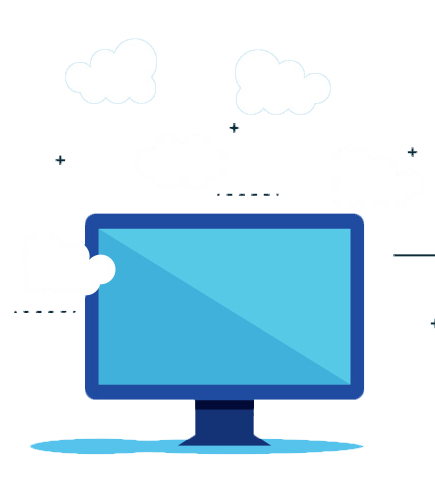Virtual Desktops vs Traditional Hardware: Evaluating the Right Choice for your Business
Every time a new technology is introduced on the market, it receives a certain response. Some welcome it with open arms while others doubt it and stick to their traditional practices. One such technology is the virtual desktop. Its advent had and will continue to revolutionize the way businesses work.
The benefits offered by this new technology are fueling businesses by enhancing efficiency. Virtual desktops have become a catalyst for business operations, overcoming challenges such as hardware limitations, high costs, and complex data management.
Every innovation comes with its own limitations and faces comparison. Virtual desktops are no exception. Comparing it to traditional setups has been a matter of frequent discussion. Often there is a debate about the role of virtual desktops versus traditional hardware. This blog underlines the significance of virtual desktops and traditional hardware for businesses and draws a clear picture of their relevance.
What Is a Virtual Desktop?
A virtual desktop runs operating systems hosted on a server, which can remotely be accessed from any physical desktop. It is a secure and dedicated system that stores data, shared across different computers. A Virtual Desktop Infrastructure (VDI) allows its users to access not only the vast centralized data but also a suite of applications hosted on a remote server.
These virtual desktops run on virtual machines (VMs) in a data center instead of a local physical desktop. The data stays protected and secure in a data center. The stored data and applications can be easily accessed from anywhere and any device via the Internet. All resources available on these VDIs are fully optimized and can be accessed by every user.
How Virtual Desktops Facilitate Businesses?
VDIs are the new way of working. The efficiency offered by a virtual system has accelerated business operations. Some of the benefits of using VDIs are as follows:
-
Centralized Management
VDI allows the IT departments to manage, update, and troubleshoot all the desktops from a central platform. These updates include antivirus updates, firewall settings, access control, etc. This leads to significant time savings. The ease of management ensures consistency in the software versions and security policies across all network devices.
-
Flexibility and Remote Work
Ever since virtual desktops have been introduced in business organizations, the number of remote workers has significantly increased. It lets users switch between devices and continue working without losing the workflow. Employees can easily access their desktops from any location and device, thereby facilitating flexible working arrangements.
-
Scalability
Virtual desktops are not restricted in any form and can be easily scaled up or down based on business requirements. It speeds up the process of onboarding new employees or contractors as providing new virtual desktops takes just a few minutes.
-
Cost Efficiency
There are several ways in which using VDIs proves to be cost-efficient: a central management system reduces the load on hardware, extends its lifespan, and even enables businesses to invest in less expensive devices.
There is no need for on-site IT support, which lowers the personnel and resource expenses. Often virtual desktops offer flexible licensing models that are based on the number of users instead of the number of devices.
-
Enhanced Security
Data loss while shuffling between devices is common and often impedes sharing data and working on different setups. In the case of virtual desktops, data is stored on a central server, which prevents the risk of data loss and theft.
It allows IT departments to centrally monitor operations and ensure that only authorized users have access to sensitive data. Regular data backups in the data center enhance disaster recovery and reduce the risk of data loss.
-
Unhindered Workflow
The centralized storage of data makes it easy to switch between devices and continue with the flow of work without any disruption. VDIs often include redundancy and failover mechanisms which ensure high availability and quick restoration in case of disasters.
Moreover, regional disruptions do not hinder the workflow, as data centers can be in multiple geographical areas
-
Uninterrupted Collaboration
VDI offers a unified work environment across all devices and allows employers to use the same tools, applications, and data essential for effective collaboration. It makes sharing files easier and ensures access to the same data for all team members, facilitating collaboration even in remote work models.
The Impact of Virtual Desktops Across Different Sectors
Virtual desktops are changing industry operations by offering flexible and efficient solutions. Here is a look at their impact across different sectors:
-
Virtual Desktops in Small and Medium Enterprises (SMEs)
As virtual desktops reduce hardware dependency, SMEs can save costs by investing in fewer physical systems or using older equipment. Since VDIs are scalable, these small enterprises can easily expand their IT resources as their business grows without significant upfront expenses.
-
Virtual Desktops in Large Corporations
Large corporations often require thousands of employees and various resources. Virtual desktops simplify data management by using a central server to control numerous workstations. Centralized data storage and access control enhance data security, while improved collaboration boosts overall workflow efficiency
-
Virtual Desktops in Healthcare
Virtual desktops have made healthcare operations much more efficient by removing obstacles in accessing and sharing data. Healthcare practitioners can easily retrieve patient records from various devices and locations, whether from hospitals, clinics, or during home visits, ensuring better care. Even in the event of disasters, VDIs ensure the continuity of critical medical services with minimal disruptions.
-
Virtual Desktops in Education
The changes brought by virtual desktops in education are significant. It has made online learning and hybrid education way more efficient and cost-effective. It ensures access to the same learning resources for all students which promotes equality in education. VDIs facilitate the sharing of software and applications which prevents the task of individual licensing and installation.
-
Virtual Desktops in Financial Services
The finance sector requires strict regulations for data security and privacy, which are made possible by the General Data Protection Regulation (GDPR) and the Payment Card Industry Data Security Standard (PCI-DSS). Virtual desktops meet these stringent security criteria, positively impacting the banking sector. They also allow finance professionals to securely access client records from remote locations while maintaining security standards.
-
Virtual Desktops in Legal Services
Virtual desktops facilitate access to legal documents and case files from remote locations without risking data security and ensuring efficient collaboration among legal teams. The security provided by VDI keeps the client’s data safe from prying hands.
-
Virtual Desktops in Retail
In retail businesses, handling and storage of vast numerical data is a tough task. Virtual desktops make the job easier by facilitating data storage, enabling retail staff to access the stored data and carry out the necessary analytics. This data can be of anything — inventory management, sales system, customer data, etc.
-
Virtual Desktops in Manufacturing
In the manufacturing industry, monitoring production is an important job. By using virtual desktops, engineers and managers can easily access the production data and control the systems remotely, making the process efficient. Centralized resource management of production applications ensures efficient usage of IT resources.
-
Virtual Desktops in Research and Development
The impact of virtual desktops and cloud computing in research and development is unambiguous. This new way of working has accelerated research and is helping various researchers collaborate from across the globe like never before.
In fact, this not only helps in storing sensitive research data securely but also prevents data loss. VDIs have made research and development (R&D work) cost-efficient by reducing the investment in physical infrastructures.
Challenges of Using Traditional Hardware: A Comparison
Traditional hardware used in businesses refers to a physical desktop setup, which includes various hardware devices required for smooth operation and management. Some traditional hardware is being replaced by virtual desktops. Here is a comparison of both on different criteria so that you can decide which of these suits your requirements:
-
Cost Efficiency
Traditional hardware has higher upfront costs and purchasing a new setup requires greater investment. Moreover, physical infrastructure demands regular maintenance and has high associated support costs. For physical hardware, licensing models are based on the number of devices which costs more when compared to VDI licensing models.
-
Scalability
Scaling businesses while using traditional setups requires buying new hardware, whereas virtual desktops can be much more easily scaled up or down. With VDIs, organizations need only identify their requirements and specify them to the service provider to receive the required virtual desktop access in a short time. Scaling businesses based on physical infrastructures also results in longer downtimes.
-
Management
While using a physical infrastructure, each device needs to be managed and updated individually and requires separate maintenance which is not the case with virtual desktop setups. The central control panels allow system administrators to quickly deploy updates from a single location. The same task would take substantially more time to complete on physical hardware, as the update will have to be queued and installed on each setup, individually.
-
Flexibility and Accessibility
The biggest challenge with using traditional hardware is the lack of flexibility. Employees can access data solely from their individual devices. No other user can access that data. In short, remote work is not that easy with traditional devices. Virtual setups allow users to access shared data and resources without any hassle from any location.
-
Security
With traditional setups, data is stored on individual devices, and if one of these devices is damaged, the entire dataset can be lost. There is always a higher risk of theft with these devices as well. Enforcing data security with these devices is not an easy task as every device will have to be individually monitored and regulated. With virtual desktops, there is comparatively a very low risk of data loss, and security protocol management is greatly simplified.
Why Apps4Rent Is the Best Choice for Your Virtual Desktop Solutions
At Apps4Rent, we specialize in providing top-notch virtual desktop solutions, customized to businesses of various employee sizes. With over 2 decades of experience, our services include offerings from leading providers like Citrix and Microsoft. We pride ourselves on our 24/7 support, assisting through phone, chat, and email to ensure minimal downtime and maximum productivity.
Our SSAE-certified data centers in New York and New Jersey adhere to the highest security standards, giving our clients peace of mind regarding data protection and compliance. We offer flexible pricing plans that can be customized to meet various business needs.
With transparent licensing and the ability to easily scale up by adding users to existing virtual desktops, we provide cost-effective and adaptable solutions. All in all, choosing Apps4Rent means partnering with a reliable and experienced provider.
Apps4Rent – Tier 1 Office 365 Cloud Solution Provider



